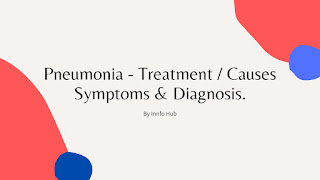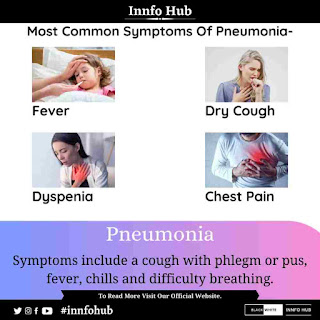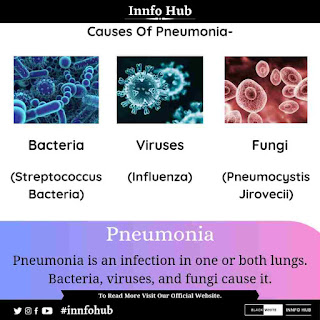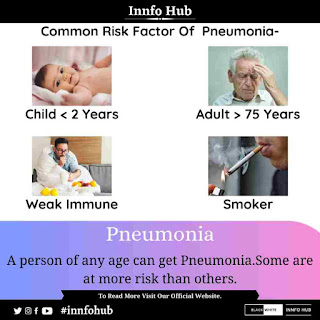Overview Of Pneumonia
Pneumonia is inflammation in one or both the lungs alveoli and it's walls.It is usually caused by the germ Pneumococcus.
Pneumonia results in fluid build-up in lungs.Fluid is basically mucus and other secretions.
In the United States 1.3 Million people were suffered from Pneumonia in a year and unfortunately 50,000 people of them died.
The average death rate of Pneumonia in United States per year is 20%.
So InnfoHub shared with you information about Pneumonia that You Should Know!
1.Pneumonia Symptoms.
2.Pneumonia Causes.
3.Pneumonia Types.
4.Pneumonia Diagnosis.
5.Pneumonia Prevention.
6.Pneumonia Treatment.
7.Pneumonia Risk Factors.
Symptoms of Pneumonia
•Pleuritic chest pain are common.
•Dyspnea-Shortness Of Breath.
•Sneezing and Nose Running.
•Sharp Dry Painful Cough.
•Vomiting and Diarrhoea.
•Fatigue of Muscles.
•Fever with Rigors.
•General Malaise.
•Body Aches.
•Nausea.
Causes of Pneumonia
•Bacteria.
•Viruses.
•Fungi.
Types Of Bacteria
Streptococcus Bacteria.
Streptococcus Bacteria is a gram-positive bacteria.This can increase White Blood Cell Count.
MycoPlasma Bacteria.
MycoPlasma Bacteria are usually known to resist the antibiotics and can cause mild respiratory infections.
Haemophilus Influenzae.
Haemophilus Influenzae is a gram-negative bacteria.This bacteria decrease the White Blood Cells Count.
Legionella Pneumophilia.
Legionella Pneumophilia is a pathogenic gram-negative bacteria.This is the root cause of all Legionnaires disease.
Types of Viruses.
Influenza (Flu).
Influenza Flu attacks the lungs and Children Old age and Pregnant Women are at high risk of getting Influenza.
Respiratory Syncytial Virus (RSV).
Respiratory Syncytial Virus is a contagious virus that can infect the respiratory tract of a person.
RhinoViruses (Common Cold).
RhinoVirus is the main cause of Common Cold.The means of spread of RhinoViruses are droplets.
The Common symptoms of RhinoVirus are:-
•Runny Nose.
•Sneezing.
•Malaise.
Fungi.
Pneumocystis Jirovecii.
Pneumocystis Jirovecii is a yeast like fungus that is a predominant cause of Pneumocystis Pneumonia.
Other fungis are:-
•Cryptococcus Species.
•Histoplasmosis Species.
Types Of Pneumonia
•Community-Aquired Pneumonia. •Hospital-Aquired Pneumonia.
•Ventilator-Associated Pneumonia.
•Aspiration Pneumonia.
Community-Aquired Pneumonia.
Community-Aquired Pneumonia is when a person gets it outside the Hospital premises.
Hospital-Aquired Pneumonia.
Hospital-Aquired Pneumonia is when a person gets Pneumonia during the Hospital stay.
Ventilator-Associated Pneumonia.
Ventilator-Associated Pneumonia is when a person is on the mechanical Ventilator.
Aspiration Pneumonia.
Aspiration Pneumonia is when the person aspires Bacteria from Foods,Saliva or stomach acid into the lungs.
Diagnose Pneumonia.
The most common ways to diagnose Pneumonia is to take the Chest X-ray of person which will show signs and symptoms.
Some other tests are:-
•Arterial Blood Gas Results.
•Pulmonary Function Tests.
•Complete Blood Count.
•Pleural Fluid Culture.
•Sputum Culture.
•CT scan.
Arterial Blood Gas Results.
Arterial Blood Gas is used to measure Carbon Dioxide and Oxygen levels in your blood.
Pulmonary Function Tests.
Pulmonary Function Test is used to know how well the lungs are functioning.This test measures:-
•Lung Volumes.
•Lungs capacity.
•Rates of Flow.
•Gas Exchange.
Complete Blood Count.
The Complete Blood Count is perform to detect disease like Infections,Anemia and Leukaemia.
The Complete Blood Count evaluate:-
•Red Blood Cells.
•White Blood Cells.
•Platelets.
Pleural Fluid Culture
Pleural Fluid Culture test perform to understand the cause of built-up fluid and detects the infection.
This test examines the fluid of the pleural space I.e between the lining of lungs and chest wall.
Sputum Culture.
Sputum Culture is a test that identifies bacteria or fungi that presents either in lungs or Respiratory passage.
CT scan.
A Computerized Tomography (CT) scans inner tissues,blood vessels,narrow bones very precisely.It is basically higher version of normal X-rays.
Pneumonia Prevention.
•Vaccination to prevent Pneumonia.
•Quit Smoking.
•Wash your hands.
•Avoid touching face and eyes.
•Take a Healthy Balanced Diet.
•Cover your mouth during sneeze.
Pneumonia Treatments
Pneumonia is treated on the basis of signs and symptoms of a person and the symptoms may differ from person to person.
A person might shifted to Mechanical Ventilator in severe cases.The Most General Methods of Treatment are:-
•Antibiotics Medication.
•Oxygen Therapy.
•Airway Clearance Therapy.
•Hyperinflation Therapy.
•Fluid Management.
Pneumonia Treatments
Pneumonia is treated on the basis of signs and symptoms of a person and the symptoms may differ from person to person.
A person might shifted to Mechanical Ventilator in severe cases.
The Most General Methods of Treatment are:-
•Antibiotics Medication.
•Oxygen Therapy.
•Airway Clearance Therapy.
•Hyperinflation Therapy.
•Fluid Management.
Antibiotics Medication.
Doctors will give you antibiotics on basis of the type of Pneumonia and patient specific characteristics such as:-
•Age
•Weight
•Allergies
•Previous Antibiotic treatment.
Your Doctor may recommend Antibiotic like:-
•Arizthromycin.【Zithromax】
•Clarithromycin. 【Biaxin XL】
•Tetracycline.【Sumycin】
Oxygen Therapy.
Oxygen Therapy is a treatment that delivers extra Oxygen for you to breathe.This therapy is used when a person is unable to get natural Oxygen [In case of Asthma & Dyspnea].
Airway Clearance Therapy.Airway Clearance Therapy is a treatment used to clean the mucus and other secretions in the respiratory pathway.
Hyperinflation Therapy.
Hyperinflation Therapy is used to expand the size of your lungs to get breathing during the case of Dyspnea (Shortness Of Breath).
This technique performs on the patient who are suffering from any kind of Respiratory distress.
Fluid Management.
According to Japanese Respiratory Society Fluid therapy is introduced to maintain the Concentration of the amounts of water and electrolytes.
Pneumonia Risk Factors
Antibiotics Medication.
Doctors will give you antibiotics on basis of the type of Pneumonia and patient specific characteristics such as:-
•Age
•Weight
•Allergies
•Previous Antibiotic treatment.
Your Doctor may recommend Antibiotic like:-
•Arizthromycin.【Zithromax】
•Clarithromycin. 【Biaxin XL】
•Tetracycline.【Sumycin】
Oxygen Therapy.
Oxygen Therapy is a treatment that delivers extra Oxygen for you to breathe.This therapy is used when a person is unable to get natural Oxygen [In case of Asthma & Dyspnea].
Airway Clearance Therapy.
Airway Clearance Therapy is a treatment used to clean the mucus and other secretions in the respiratory pathway.
Hyperinflation Therapy.
Hyperinflation Therapy is used to expand the size of your lungs to get breathing during the case of Dyspnea (Shortness Of Breath).
This technique performs on the patient who are suffering from any kind of Respiratory distress.
Fluid Management.
According to Japanese Respiratory Society Fluid therapy is introduced to maintain the Concentration of the amounts of water and electrolytes.
Pneumonia Risk Factors
A person of any age can get Pneumonia.Some are at more risk than others.So let's talk about those who are at the most risk of getting Pneumonia.
Common Risk Factors Of Pneumonia:-
•Children less than 2 years of age.
•Adults more than 65 years of age.
•Person with weak immune system.
•Person with recent respiratory infection.
•Person who needs Ventilator Support.
•Person who smoke Cigarette.
•Person who lives in Pollutive area.
•Person with chronic conditions like:-
Asthma.
COPD
CHF.
----------Artciles You May Like!
1.Vegan Vitamin D Foods.
2.Weight Loss Tips.
3.Best Ways To Gain Muscle
4.Get Glowing Skin Overnight.
5.10 Best Healthy Protein Foods.
A person of any age can get Pneumonia.Some are at more risk than others.So let's talk about those who are at the most risk of getting Pneumonia.
Common Risk Factors Of Pneumonia:-
•Children less than 2 years of age.
•Adults more than 65 years of age.
•Person with weak immune system.
•Person with recent respiratory infection.
•Person who needs Ventilator Support.
•Person who smoke Cigarette.
•Person who lives in Pollutive area.
•Person with chronic conditions like:-
Asthma.
COPD
CHF.
1.Vegan Vitamin D Foods.
2.Weight Loss Tips.
3.Best Ways To Gain Muscle
4.Get Glowing Skin Overnight.
5.10 Best Healthy Protein Foods.









Nice information..
ReplyDelete👍
Thanx Pravin.
DeleteDo Subscribe for More Articles!
Post a Comment